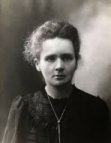 Marie Sklodowska Curie
Marie Sklodowska Curie
Polish-Born Chemist and Physicist
1867-1934 A.D.
“One never notices what has been done; one can only see what remains to be done.” ~Marie Curie, letter to her brother, 1894.
Maria Sklodowska-Curie was one of the first woman scientists to win worldwide fame, and indeed, one of the great scientists of this century . A noted chemist and physicist Marie Curie was born Marie Sklodowska, the youngest of five children, in Warsaw , Poland on November 7, 1867 , to noted educators Wladyslaw and Bonislaw Sklodowska. Her father was the president of Lublin University and her mother taught in several universities in Warsaw .
Early in life, Marie discovered her love for physics and chemistry and she dreamed of studying at the Sorbonne, in Paris. She realized that dream and graduated from the Sorbonne in 1894.
In 1895, Marie married Pierre Curie, a professor of physics at the School of Physics and Chemistry in Paris , France . They became the parents of two daughters, Irene and Eve. In 1898, the Curies announced the discovery of the elements polonium (named after Poland ) and radium. Shortly after these discoveries, Marie was awarded her doctorate.
In 1903, Marie, along with her husband Pierre, was awarded the Nobel Prize for physics.
After her husband’s death in 1906, she was asked to succeed him in his professorship in physics at the Sorbonne. This was the first time such an honor was bestowed upon a woman. In 1911, Madame Curie received a second Nobel Prize for chemistry, thus becoming the first person and only woman in history to be awarded two Nobel Prizes. Also in 1911, by appointment of a commission of scientists, Madame Curie prepared the international standard of radium chloride, which is preserved in the International Bureau of Weights and Measures. During Marie’s lifetime, she received over 125 degrees, medals, and decorations from universities and organizations around the world.
Marie Curie died on July 4, 1934 . She is the first woman which has been laid to rest under the famous dome of the Pantheon in Paris for her own merits.
Her daughter, Irene, was also a gifted chemist, continuing the accomplishments of her parents in the fields of physics and chemistry.

